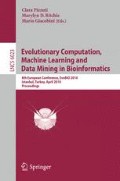Abstract
The prediction of a minimum-energy protein structure from its amino-acid sequence represents one of the most important and challenging problems in computational biology. A new evolutionary model based on hill-climbing genetic operators is proposed to address the hydrophobic - polar model of the protein folding problem. The introduced model ensures an efficient exploration of the search space by implementing a problem-specific crossover operator and enforcing an explicit diversification stage during the evolution. The mutation operator engaged in the proposed model refers to the pull-move operation by which a single residue is moved diagonally causing the potential transition of connecting residues in the same direction in order to maintain a valid protein configuration. Both crossover and mutation are applied using a steepest-ascent hill-climbing approach. The resulting evolutionary algorithm with hill-climbing operators is successfully applied to the protein structure prediction problem for a set of difficult bidimensional instances from lattice models.
Access this chapter
Tax calculation will be finalised at checkout
Purchases are for personal use only
Preview
Unable to display preview. Download preview PDF.
References
Berenboym, I., Avigal, M.: Genetic algorithms with local search optimization for protein structure prediction problem. In: GECCO 2008, pp. 1097–1098 (2008)
Cotta, C.: Protein Structure Prediction Using Evolutionary Algorithms Hybridized with Backtracking. In: Mira, J., Álvarez, J.R. (eds.) IWANN 2003. LNCS, vol. 2687, pp. 321–328. Springer, Heidelberg (2003)
Crescenzi, P., Goldman, D., Papadimitriou, C.H., Piccolboni, A., Yannakakis, M.: On the Complexity of Protein Folding. Journal of Computational Biology 50, 423–466 (1998)
Dill, K.A.: Theory for the folding and stability of globular proteins. Biochemistry 24(6), 1501–1509 (1985)
Hart, W., Newman, A.: Protein Structure Prediction with Lattice Models. In: Handbook of Computational Molecular Biology. Chapman & Hall CRC Computer and Information Science Series (2006)
Hsu, H.P., Mehra, V., Nadler, W., Grassberger, P.: Growth algorithms for lattice heteropolymers at low temperatures. J. Chem. Phys. 118(1), 444–451 (2003)
Khimasia, M.M., Coveney, P.V.: Protein structure prediction as a hard optimization problem: the genetic algorithm approach. Molecular Simulation 19, 205–226 (1997)
Krasnogor, N., Blackburnem, B., Hirst, J.D., Burke, E.K.: Multimeme algorithms for protein structure prediction. In: Guervós, J.J.M., Adamidis, P.A., Beyer, H.-G., Fernández-Villacañas, J.-L., Schwefel, H.-P. (eds.) PPSN 2002. LNCS, vol. 2439, pp. 769–778. Springer, Heidelberg (2002)
Lesh, N., Mitzenmacher, M., Whitesides, S.: A complete and effective move set for simplified protein folding. In: RECOMB 2003: Proceedings of the seventh annual international conference on Research in computational molecular biology, pp. 188–195. ACM, New York (2003)
Lozano, M., Herrera, F., Krasnogor, N., Molina, D.: Real-coded memetic algorithms with crossover hill-climbing. Evol. Comput. 12(3), 273–302 (2004)
Shmygelska, A., Hernandez, R., Hoos, H.H.: An Ant Colony Algorithm for the 2D HP Protein Folding Problem. In: Dorigo, M., Di Caro, G.A., Sampels, M. (eds.) Ant Algorithms 2002. LNCS, vol. 2463, pp. 40–53. Springer, Heidelberg (2002)
Song, J., Cheng, J., Zheng, T., Mao, J.: A Novel Genetic Algorithm for HP Model Protein Folding. In: PDCAT 2005: Proceedings of the Sixth International Conference on Parallel and Distributed Computing Applications and Technologies, pp. 935–937. IEEE Computer Society, Los Alamitos (2005)
Unger, R., Moult, J.: Genetic algorithms for protein folding simulations. J. Molec. Biol. 231, 75–81 (1993)
Zhao, X.: Advances on protein folding simulations based on the lattice HP models with natural computing. Appl. Soft. Comput. 8(2), 1029–1040 (2008)
Author information
Authors and Affiliations
Editor information
Editors and Affiliations
Rights and permissions
Copyright information
© 2010 Springer-Verlag Berlin Heidelberg
About this paper
Cite this paper
Chira, C., Horvath, D., Dumitrescu, D. (2010). An Evolutionary Model Based on Hill-Climbing Search Operators for Protein Structure Prediction. In: Pizzuti, C., Ritchie, M.D., Giacobini, M. (eds) Evolutionary Computation, Machine Learning and Data Mining in Bioinformatics. EvoBIO 2010. Lecture Notes in Computer Science, vol 6023. Springer, Berlin, Heidelberg. https://doi.org/10.1007/978-3-642-12211-8_4
Download citation
DOI: https://doi.org/10.1007/978-3-642-12211-8_4
Publisher Name: Springer, Berlin, Heidelberg
Print ISBN: 978-3-642-12210-1
Online ISBN: 978-3-642-12211-8
eBook Packages: Computer ScienceComputer Science (R0)

